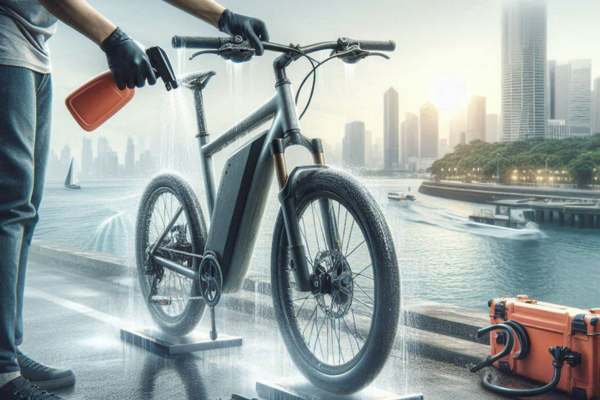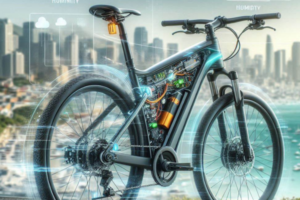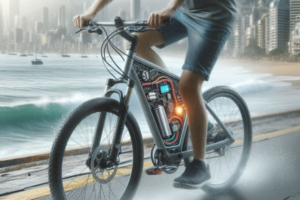🌬️ Why Humidity Demands Smarter E-Bike Care
Electric bicycles offer a sustainable, efficient, and enjoyable mode of transport — especially in urban and coastal environments. But in areas with high humidity, your e-bike’s performance can suffer silently if you’re not paying attention. Humidity may seem harmless compared to heavy rain or direct saltwater exposure, but over time it can compromise your battery, drivetrain, and electrical systems. And when these elements degrade, energy efficiency takes a hit.
Understanding how humidity interacts with your e-bike and how to counteract its effects is the first step toward protecting your investment and enjoying consistently strong performance. In this guide, we’ll break down the hidden threats of humidity, how they affect energy consumption, and what you can do to ensure your ride remains smooth, safe, and powerful.
⚙️ How Humidity Affects Energy Efficiency
Humidity affects your e-bike in multiple ways — some mechanical, some electrical. Even if you don’t ride through puddles or storms, humid air alone creates problems that build up over time. Let’s break down the specific areas affected:
- 🔌 Battery efficiency: High humidity increases the chance of internal condensation inside the battery casing. This affects voltage output and can reduce the number of usable cycles.
- ⚠️ Electrical contact points: Moisture builds up in charging ports, display units, throttle connectors, and brake sensors, leading to short circuits or power inconsistencies.
- ⛓️ Chain and drivetrain friction: When humidity mixes with dust or road debris, it forms a sticky layer on the chain and gears, increasing resistance and energy consumption.
- 🛑 Brake drag: Oxidation forms on brake rotors and pads, slightly altering alignment and causing micro-resistance with every rotation. Your motor works harder as a result.
- 💨 Tire performance: Lower ambient pressure combined with moisture may cause tire PSI to drop slightly, increasing rolling resistance and reducing energy efficiency per charge.
These impacts are not always noticeable day to day. But they accumulate. Riders in humid environments often experience a drop in range of 10–20% without realizing why. The solution isn’t always replacing the battery — it’s creating a routine that protects energy from the air itself.
💡 Insight from the Mist
“Humidity doesn’t rust your bike overnight — it wears it down one ride at a time. And where moisture lingers, energy escapes.”
In the next sections, we’ll guide you through practical routines, protective upgrades, and real-life strategies to prevent the invisible energy loss caused by humid climates. Whether you live by the sea or in a rainy inland city, these techniques will empower you to take full control of your e-bike’s performance and efficiency.
🛠️ Weekly Maintenance Routine to Preserve Energy in Humid Conditions
Preserving your electric bicycle’s energy efficiency in a humid environment requires more than just charging and riding. It involves developing a maintenance routine that addresses the slow and silent effects of moisture. A small amount of effort each week can translate into more miles per charge, smoother rides, and longer-lasting components.
The goal is not just cleanliness — it’s about energy preservation. By keeping key components dry, protected, and properly lubricated, you reduce drag, improve power delivery, and avoid premature energy losses caused by environmental wear.
✅ Your Humidity-Fighting Maintenance Checklist
- 🧽 Wipe down after each ride: Use a clean, dry microfiber cloth to remove surface moisture. Focus especially on the chain, motor casing, display screen, and brake areas.
- 🛢️ Lubricate the drivetrain weekly: Humid environments break down chain lube faster. Use a wet-condition lubricant and reapply every 5–7 days or after rainy rides.
- 🔍 Inspect brake rotors and pads: Look for oxidation or squeaking. Clean rotors with isopropyl alcohol and ensure pads are dry and aligned properly.
- ⚡ Clean and dry battery connectors: Moisture or dust in the charging port and terminals can affect performance. Use compressed air or a dry brush to keep these areas clean.
- 💨 Monitor tire pressure weekly: Humidity and temperature changes can cause pressure shifts. Low PSI increases rolling resistance and drains your battery faster.
- 🏠 Store your e-bike and battery indoors: Avoid sealed plastic covers or garages that trap humidity. A cool, ventilated indoor space helps prevent corrosion.
This routine takes just 15–20 minutes per week and can prevent up to 25% in avoidable energy loss. You’ll feel the difference in smoother acceleration, quieter riding, and a more predictable range — even on the most humid days.
📊 Comparative Table: Humid vs. Dry Weather Maintenance
| Maintenance Task | Dry Weather | Humid Weather |
|---|---|---|
| Chain lubrication | Every 2–3 weeks | Weekly or after wet rides |
| Connector cleaning | Monthly | Weekly |
| Tire pressure check | Bi-weekly | Weekly |
| Brake inspection | Monthly | Weekly |
💬 Energy Tip
“You don’t need high-tech gear to protect your ride — just high-awareness. Routine is the secret to range.”
As you incorporate this checklist into your weekly habits, you’ll start to notice more than just improved battery performance. You’ll ride with confidence, knowing you’ve prepared for the climate you live in. And your e-bike will reward you with every charge.
🌍 Real Story: A Rider’s Journey to Efficiency in a Coastal City
Lucas lives in Tampa, Florida — a city known for its sunshine, but also for its year-round humidity. When he bought his first electric bicycle, he used it for everything: commuting, errands, weekend beach rides. But after six months, his range dropped from 45 km per charge to barely 30. His chain was noisy, his brakes felt sluggish, and his bike didn’t accelerate like it used to.
Assuming the battery was failing, Lucas considered buying a replacement. Instead, he visited a local repair shop. The technician showed him subtle rust buildup on his chain, dirt in the brake pads, and corrosion inside the charging port. None of it was dramatic — but together, these tiny inefficiencies were draining power from every ride.
With some guidance, Lucas started a new weekly care routine: wiping down his bike after humid mornings, re-lubricating his chain with wet-condition oil, checking his tire pressure every Friday, and storing his battery indoors. Within three weeks, his range increased by nearly 25%, and he no longer felt like he was “fighting the bike.”
His experience is a powerful reminder: you don’t always need new parts — sometimes, you just need new habits.
🔧 Smart Upgrades for Riders in Humid Climates
Alongside weekly care, a few targeted upgrades can make a big difference in energy preservation. These aren’t expensive changes — they’re smart investments that extend your e-bike’s life and protect your ride in moist environments.
- 🔩 Stainless steel drivetrain parts: Replace vulnerable chainrings, bolts, and screws with corrosion-resistant options. They prevent friction buildup and reduce mechanical drag.
- 🛢️ High-performance wet-condition lubricants: These stay on longer in humid conditions, reduce squeaking, and improve power transfer from the pedals and motor.
- ⚡ Rubber charging port caps: Simple silicone covers help seal the battery terminal from ambient moisture and dust — a small addition with major impact.
- 🚲 Full mudguards and splash protection: These minimize water splash on the chain, motor, and controller — keeping critical areas cleaner and drier.
- 🧼 Nano-protective sprays: These create a hydrophobic coating on frames and sensitive components, repelling water and reducing the chance of corrosion.
Most of these upgrades cost less than a single battery replacement, but they can add months — or even years — to the life of your current components. More importantly, they help maintain your bike’s intended range and power output, even in challenging climates.
💬 Encouraging Thought
“Humidity can’t be stopped — but it can be outsmarted. Every drop of care you give your e-bike gives back in distance and durability.”
Efficiency doesn’t just come from battery specs or motor wattage. It comes from attention, intention, and a willingness to protect the machine that powers your day. The more you give, the more you gain — one charge at a time.
🚫 Common Mistakes That Drain Energy in Humid Environments
Even well-intentioned riders unknowingly reduce their electric bicycle’s performance simply by overlooking small but impactful details. In humid climates, these mistakes add up quickly. While they may not cause immediate breakdowns, they gradually chip away at energy efficiency, battery health, and overall ride quality.
Let’s look at the most frequent errors — and how you can easily avoid them.
- ❌ Neglecting chain care: In humid air, chain lubricant breaks down faster. If you wait too long to reapply, friction increases — draining energy from your motor and legs.
- ❌ Charging a damp battery: After a humid ride, moisture often builds around the charging port. Plugging in without drying it first can lead to corrosion or short-term performance issues.
- ❌ Storing the bike in a sealed garage or under plastic: Many riders think a tight cover protects the bike, but in humid areas, it traps moisture and accelerates oxidation.
- ❌ Ignoring small performance dips: Slight range loss, brake squeaks, or chain noise may seem minor. But in humid conditions, they’re often early signs of energy inefficiency.
- ❌ Assuming “weatherproof” means “maintenance-free”: While many e-bikes have water-resistant designs, they’re not immune to humidity buildup. Regular care is still essential.
These mistakes are common because they’re easy to make — especially for new riders. But once you’re aware of them, prevention becomes simple. The key is developing habits that catch small issues before they grow into costly problems or energy losses.
📋 Weekly Efficiency Checklist for Humid Weather
To protect your battery, motor, and components from moisture damage, try adopting this weekly checklist. It requires minimal effort and can significantly improve your riding experience and energy conservation.
- ✅ Wipe down key components daily: Battery casing, display screen, chain, brake rotors, and motor housing.
- ✅ Apply chain lubricant every 5–7 days: Especially after wet rides or high-humidity mornings.
- ✅ Inspect brake rotors for residue: Clean using alcohol and a dry cloth if you notice film or noise.
- ✅ Check tire pressure weekly: Humid weather combined with temperature changes can reduce PSI.
- ✅ Dry the charging port before every charge: Use a soft cloth or air to remove invisible moisture.
- ✅ Store the battery indoors if possible: This keeps it at optimal temperature and away from humidity spikes.
This checklist isn’t meant to replace professional servicing — it’s designed to reduce the need for it. With just a few minutes each week, you preserve range, extend component life, and ride with greater peace of mind.
💡 Energy Reminder
“A well-maintained e-bike doesn’t just go farther — it carries your care with every kilometer.”
In humid climates, control what you can: your routine, your tools, and your awareness. When you approach maintenance as part of the ride — not as an afterthought — your bike responds with power, consistency, and longevity.
❓ Frequently Asked Questions (FAQs)
How much energy loss can humidity cause?
In humid climates, riders often experience 10–25% reduction in range, depending on how well the bike is maintained. Moisture increases resistance in the drivetrain, disrupts electrical contacts, and accelerates wear on moving parts — all of which force your e-bike to work harder per kilometer.
What’s the best type of chain lubricant for humid weather?
Look for wet-condition or marine-grade lubricants that are designed to stay on the chain longer and resist water wash-off. PTFE or ceramic-infused lubes provide excellent protection and performance in moist conditions.
Should I remove the battery after every ride?
If you live in a coastal or high-humidity environment, it’s recommended to store your battery indoors when possible. This helps prevent internal condensation and extends overall battery life.
Are full fenders necessary for energy efficiency?
Yes — especially in humid or rainy regions. Full fenders help prevent water and road debris from splashing onto the drivetrain, motor, and electrical parts. They minimize moisture contact and reduce cleaning time and corrosion risk.
Can I still store my bike outside under a cover?
If outdoor storage is your only option, choose a breathable bike cover specifically made for humid climates. Avoid tightly sealed plastic covers — they trap moisture and can do more harm than good. Ventilation is key.
💬 Final Thoughts
Humidity may be invisible, but its impact is real. It doesn’t crash into your ride all at once — it arrives quietly, softly, through the air, and settles on your components. But here’s the truth: you are not powerless against it.
With the right routine, upgrades, and awareness, your electric bicycle can remain as efficient, fast, and responsive as the day you bought it — even in the wettest cities. Energy loss doesn’t have to be your reality. Care is your superpower.
Let this article be a reminder that smart riding begins with smart care. Your e-bike reflects your habits. And when you treat it with attention and consistency, it rewards you with distance, comfort, and reliability — no matter the climate.
🌟 We Want to Hear from You
Do you ride in a humid city? Have you struggled with battery performance or range loss in damp environments? Maybe you’ve discovered a simple tip that made a big difference in your ride?
Share your experience in the comments below. Your insight can help other riders learn, improve, and protect their e-bikes more effectively.
Let’s build a community of smart, mindful cyclists who ride farther — together.



